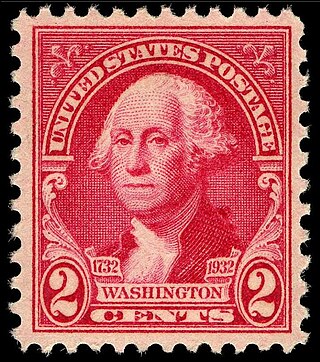
The Washington Bicentennial stamps of 1932 are postage stamps issued by the United States government in 1932 to commemorate the 200th anniversary of U.S. President George Washington's birth. Twelve stamps were issued as a collection, with each one depicting the President in a different period in his life.

For postage stamps, separation is the means by which individual stamps are made easily detachable from each other.

Postal service in the United States began with the delivery of stampless letters whose cost was borne by the receiving person, later encompassed pre-paid letters carried by private mail carriers and provisional post offices, and culminated in a system of universal prepayment that required all letters to bear nationally issued adhesive postage stamps.

A definitive stamp is a postage stamp that is part of the regular issue of a country's stamps, available for sale by the post office for an extended period of time and designed to serve the everyday postal needs of the country. The term is used in contrast to a "provisional stamp", one that is issued for a temporary period until regular stamps are available, or a "commemorative stamp", a stamp "issued to honor a person or mark a special event" available only for a limited time. Commonly, a definitive issue or series includes stamps in a range of denominations sufficient to cover current postal rates. An "issue" generally means a set that is put on sale all at the same time, while a "series" is spread out over several years, but the terms are not precise. Additional stamps in a series may be produced as needed by changes in postal rates; nevertheless some values may be permanently available, regardless of prevailing rates; examples include 1c or 1p and $1 or £1.

Black Jack or Blackjack was the 2-cent denomination United States postage stamp issued from July 1, 1863 to 1869, is generally referred to as the "Black Jack" due to the large portraiture of the United States President Andrew Jackson on its face printed in pitch black. It is considered to be a key stamp in any collection of US stamps.

The Benjamin Franklin Z Grill, or simply "Z-Grill", is a 1-cent postage stamp issued by the United States Postal Service in February 1868 depicting Benjamin Franklin. While stamps of this design were the common 1-cent stamps of the 1860s, the Z-Grill is distinguished by having the so-called "Z" variety of a grill pressed into the stamp, creating tiny indentations in the paper. Although the 1-cent Franklin Z-Grill is generally cited as the rarest and most valuable of all US postage stamps, the 15-cent Lincoln Z-Grill is just as rare, also with only 2 known to exist. The 10-cent Washington Z-Grill scarcely less rare with only 6 known to exist. First production runs of Z-Grill process were made of the common Z-grill denominations - the 2-cent Jackson, 3-cent Washington, and 12-cent Washington stamps. The earliest known postmarks of these Z-grill stamps date from January 1868. Then in February 1868 three other denominations were printed with the Z. Grill, the above mentioned 1-cent Franklin, 10-cent Washington and 15-cent Lincoln stamps. These three denominations were only in production for a short period of time with only about 1000 of each being printed before production shifted to the F-grill - resulting in the rarity of these 3 stamps.

The United Nations Postal Administration (UNPA) is the postal agency of the United Nations. It issues postage stamps and postal stationery, denominated in United States dollars for the office in New York, in Swiss francs for the office in Geneva and in euros for the office in Vienna. As such, UNPA is the only postal authority that issues stamps in three different currencies.

The Hawaiian Missionaries are the first postage stamps of the Kingdom of Hawaii, issued in 1851. They came to be known as the "Missionaries" because they were primarily found on the correspondence of missionaries working in the Hawaiian Islands. Only a handful of these stamps have survived to the present day, and so they are amongst the great rarities of philately.

Postage stamps and postal history of the Canal Zone is a subject that covers the postal system, postage stamps used and mail sent to and from the Panama Canal Zone from 1904 up until October 1978, after the United States relinquished its authority of the Zone in compliance with the treaty it reached with Panama.
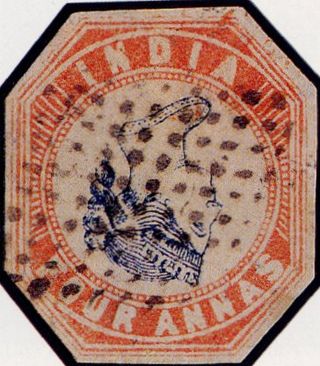
The Inverted Head Four Annas of India is a postage stamp prized by collectors. The 1854 first issues of India included a Four Annas value in red and blue. It was one of the world's first multicolored stamps; the Basel Dove preceded it by nine years. However, an invert error occurred during production, showing the head "upside down."

The Presidential Issue, nicknamed the Prexies by collectors, is the series of definitive postage stamps issued in the United States in 1938, featuring all 29 U.S. presidents who were in office between 1789 and 1928, from George Washington to Calvin Coolidge. The presidents appear as small profile busts printed in solid-color designs through 50¢, and then as black on white images surrounded by colored lettering and ornamentation for $1, $2, and $5 values. Additional stamps in fractional-cent denominations offer busts of Benjamin Franklin and Martha Washington, as well as an engraving of the White House. With its total of 32 stamps, this was the largest definitive series yet issued by the U. S. Post Office.

The Rare 2d Coil was an experimental vertical coil stamp, denominated 2d, issued by the Irish Post Office in 1935 and is one of the scarcest, and most valuable, Irish stamps. It is often referred to by stamp collectors simply as "Scott 68b" or "SG 74b", being the Scott and Stanley Gibbons stamp catalogue numbers respectively.

The postal history of Turkey and its predecessor state, the Ottoman Empire, dates to the 18th century when foreign countries maintained courier services through their consular offices in the Empire. Although delayed in the development of its own postal service, in 1863 the Ottoman Empire became the second independent country in Asia to issue adhesive postage stamps, and in 1875, it became a founding member of the General Postal Union, soon to become the Universal Postal Union. The Ottoman Empire became the Republic of Turkey in 1923, and in the following years, its postal service became more modernized and efficient and its postage stamps expertly designed and manufactured.
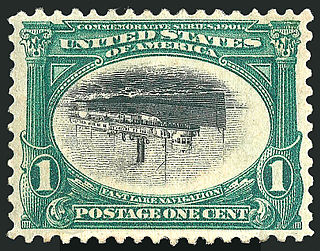
As part of the Pan-American Exposition held in Buffalo in 1901 the United States Post Office Department issued a series of six commemorative stamps. Each stamp featured an ornate colored frame enclosing a black-and-white image of some means of modern rapid transportation. In the standard American Scott catalog, these six stamps carry the numbers 294-299. The first day of issue for the stamps was May 1, 1901.
Admirals are a series of definitive stamps issued by three countries of the British Commonwealth that show King George V of Great Britain and the British Dominions. The stamps are referred to as the Admirals because King George is depicted in his Admiral of the Fleet uniform. The stamps were issued by Canada in 1911–1928, New Zealand in 1926, and Rhodesia in 1913–24.
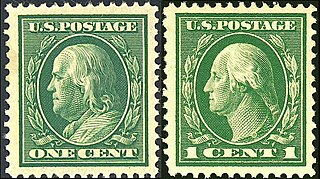
The Washington–Franklin Issues are a series of definitive U.S. Postage stamps depicting George Washington and Benjamin Franklin, issued by the U.S. Post Office between 1908 and 1922. The distinctive feature of this issue is that it employs only two engraved heads set in ovals—Washington and Franklin in full profile—and replicates one or another of these portraits on every stamp denomination in the series. This is a significant departure from previous definitive issues, which had featured pantheons of famous Americans, with each portrait-image confined to a single denomination. At the same time, this break with the recent past represented a return to origins. Washington and Franklin, after all, had appeared on the first two American stamps, issued in 1847, and during the next fifteen years, each of the eight stamp denominations available featured either Washington or Franklin.

The 1869 Pictorial Issue is a series of definitive United States postage stamps released during the first weeks of the Grant administration. Ten types of stamp in denominations between one cent and ninety cents were initially offered in the series, with eight of these introduced on March 19 and 20, 1869 and the two greatest values being distributed somewhat later. During May, however, the Post Office began distributing a revised version of the 15-cent stamp, in which the original, poorly aligned frame had been modified ; and collectors consider this eleventh stamp an integral part of the Pictorial Issue. The two 15-cent stamps were assigned separate Scott Catalogue numbers: 118 and 119.

The St. Louis Bears are a set of Provisional stamps issued by the St. Louis Post office in 1845-46 to facilitate prepayment of postal fees at a time when the United States Post Office had not yet issued postage stamps for national use. St. Louis, whose postmaster, John M. Wimer, instigated the production, was one of eleven cities to produce such stamps. Bears were offered in three denominations: 5¢, 10¢ and 20¢; the earliest known postmark date on a stamp of the issue is November 13, 1845.
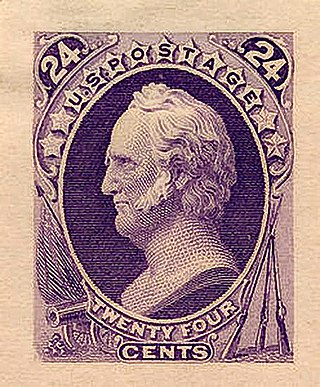
The Lost Continental is a light-purple 24¢ United States postage stamp depicting General Winfield Scott, printed around 1873 on vertically ribbed paper by the Continental Banknote Company. It is the only known copy of this 24¢ Scott stamp—among the many surviving examples—that can be positively identified as a printing by the Continental firm, and not by the National Banknote Company, which had originally produced this 24¢ issue three years earlier. For more than a century, experts could not determine with certainty whether Continental had ever, in fact, printed its own version of this stamp—or, if it had done so, whether any of the copies it printed survived. Conclusive evidence did not begin to emerge until a collector named Eraldo Magazzu discovered the Lost Continental while examining a lot of old stamps he had purchased in 1967. Much debate and analysis followed before the stamp, on the evidence of its paper-type, was finally certified as authentic by the Philatelic Foundation in 1992. How many other copies of this Scott issue printed on normal paper by Continental still exist is a question that philatelists believe will never be answered. Despite this uncertainty about the stamp's actual degree of rarity, the Lost Continental sold for $325,000 at a Siegel Gallery auction in December, 2004 A photograph of the stamp appeared on the front cover of the catalogue for that auction; on page 60 of the catalogue, a photograph of the Lost Continental's back shows the pencil mark "153", a Scott catalogue number that erroneously identifies the stamp as an example printed by the National Banknote Company.



















